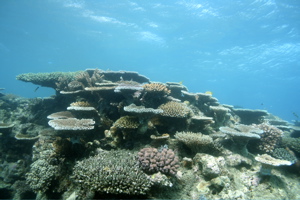 |
| View of shallows |
July 11, 2006-July 14, 2006
Lizard Island, a high continental island, is surrounded by fringing reef. The reefs connect the neighboring islands: Palfrey Island, Seabird Island and South Island. The Lizard Island reef study was conducted on the north end, in Mermaid Cove. Coral patches and numerous scattered coral pinnacles fringe the entire cove.
The study at Lizard Island’s Mermaid Cove took place over a four-day period. During this time, the water temperature remained very constant, ranging from 23.3-23.9°C.
Minimal bleaching was recorded during the Vitareef data collection in Mermaid Cove. Slightly over 1% of the corals in the deep zone showed signs of bleaching and less than 0.5% of the corals in the shallow zone showed signs of bleaching.
No evidence of diseases on corals was observed in Mermaid Cove.
Visibility over the study period ranged from 37-51 ft. Many days the water appeared cloudy, not turbid, which was probably due to strong winds stirring up sediment on the bottom. Due to the shallow depths of Mermaid Cove, all Secchi disk readings were collected horizontally.
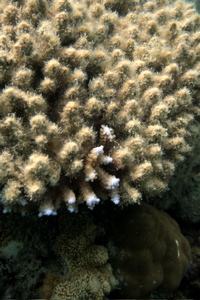 |
| Acropora
sp. with damaged tissue overgrown by algae |
Crown of thorns sea stars were observed on the reef on several occasions over the course of this study. During the four transects, one crown of thorns was sighted. Three were observed just outside the transect area. Several crown of thorns and evidence of crown of thorns damage were observed on the training and Vitareef dives. The density of crown of thorns was not high, but their presence was noticed.
According to employees at the dive resort on Lizard Island, Mermaid Cove had experienced an outbreak of crown of thorns five or six years ago. Presently, the crown of thorns population seems to be at a more balanced level.
Fifty miles north of Cooktown and fifteen miles northeast of Lookout Point lies Lizard Island. Lizard Island stands three hundred fifty eight meters above sea level at its highest point, Cooks Lookout, and provides a vantage distance of thirty miles or more on a clear day. Legendary Lt. Commander James Cook used this position to survey the outer barrier reef to seek escape for the MS Endeavour from the shoals of the coast in 1770.
Lizard Island is a high island, which was part of the mainland prior to the last glaciation period. As sea temperature increased and sea level rose, ocean inundated the lower continental margin, eventually separating Lizard Island from the mainland. Two smaller islands, Palfrey Island and South Island, accompany Lizard Island. In addition, two neighboring islets, Osprey Islet and Seabird Islet, house seabird rookeries. A combination of reef, water, and sand connect these dry and rocky landmasses.
Lizard Island has a long story of magic, attracting both ceremony and exploitation. Prior to the influx of anxious miners and fishermen into North Queensland, Aborigines lived and dined off the bountiful riches both on land and offshore. Lizard Island was a place of power utilized by Aborigines for ceremonial purposes. Existing rock formations on the slopes of Cooks Lookout and a diary revealing the tragedy of a foreign enterprise give credence to this theory of thought. The prized commodity, beche-de-mer attracted the Watson family and partner Fuller to establish a base on Lizard Island. They built a small cottage and planted seeds of a promising future. In pursuit of beche-de-mer, Mr. Watson and Fuller sailed north, leaving Mary Watson, their new born and two Chinese servants. Days passed leisurely until one servant went missing and another was ambushed by angered Aborigines leaving him severely injured. Badly wounded, the servant helped launch a beche-de-mer boiling tub in which the three of them made their escape, only to perish from thirst.
Today, Low Isles is part of the Great Barrier Reef Marine Park (GBRMP) and the Great Barrier Reef Heritage Area. In addition, Low Isles is also protected as a sensitive area by the Cairns Area Plan of Management. Under the GBRMP zonation plan July 2004, Low Isles is designated a green zone. Greens zones are strictly no-take zones. Activities such as fishing or collecting are not permitted, however diving, snorkeling, swimming, boating, and sailing are allowed. Commercially, 300 tourists per day are licensed to visit Low Isles by boat. However, an average of approximately 150 people per day visit this area, many of whom are swimming, snorkeling or diving this reef.
Lizard Island hosts two permanent establishments today. A marine biology research station hugs the south side of the island and an up-market resort owned by Australian Airlines sits on the shores of Anchor Bay to the north. People come and go by aircraft and or launch from Cairns and Cooktown.
Lizard Island rests within the Great Barrier Reef Marine Park, which stretches from the tip of Cape York in Queensland, south to Bundaberg. Queensland has further incorporated Lizard Island into the Queensland State Marine Park complementing the Great Barrier Reef Marine Park by conserving the intertidal area. The Great Barrier Reef Park Zoning Plan 2003 and Queensland zoning plans balance human use and conservation in a complex quilt of defined activity. Under these planning laws, Lizard Island, reef, water, sand and accompanying satellites are designated as a Marine National Park Zone, a Scientific Research Zone and a Conservation Park Zone. All zones allow public access, but restrict certain activities. The Scientific Research Zone is managed by the research station. The Conservation Park Zone is a fifteen hundred meter wide band of protected area around the northwest tip of the island and is further defined as a Public Appreciation Special Management Area restricting spearfishing and harvesting of aquaculture but allowing limited line fishing, one line/one hook per person.
Mermaid Cove, protected from the strong southeasterly trade winds, has a beach with rocky outcroppings at both ends. Around the rocky spits of Mermaid Cove, fringing reef extends from the low tide mark to a depth of 8 meters where it meets sandy bottom. Coral bommies lie directly off the beach in the cove starting in 1 meter and extending to 8 meters. At the foot of the bommies is sandy bottom.
Four different transects were laid in the cove; two in a shallow zone (3-5m) and two in a deep zone (6-8m). Vitareef data was collected in each transect zone.
The cove has two mooring buoys, one directly off the central portion of the beach and the other on the northeastern rock spit.
A high diversity of coral genera was observed on the four transects with a total of 42 genera present. Other genera were observed during the Vitareef data collection. A total of 46 coral genera were observed over the course of the entire study.
A number of recently dead table Acropora spp. colonies were observed. We noticed many colonies that are healthy now, but had entire sections that are overgrown with algae. We believe that this condition was a remnant of the prior crown of thorns infestation.
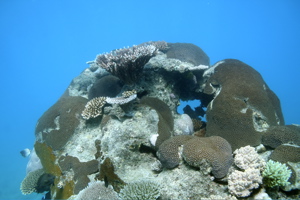 |
| Massive Diploastrea heliopora decreasing in size due to edge damage |
The dominant condition affecting coral colonies was edge damage. This is the condition where fine filamentous algae traps sediment, killing the underlying tissue. The colony continues to decrease in size as the patch of algae propagates, creating a visible fine white line.
We observed a fair amount of algal/coral competition. It seemed that many of the threatened colonies (mainly the ones afflicted with edge damage) had to contend with macroalgae and filamentous algae growing around the edges of the colonies, but very few obvious examples of actual macroalgae overgrowth or filamentous mat smothering were noted.
Acropora spp. and Porites spp. were the dominant coral genera on this reef. In some areas there were many Montipora spp. present. There was a high concentration of newly recruited corals observed throughout our dives. These young colonies were healthy and present in a large array of genera.
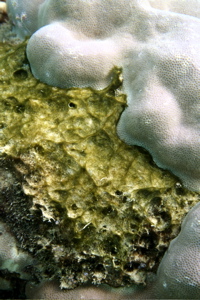 |
| Algae/coral competition |
Striking corals were seen on the shallow patch by the north side of the cove. We observed beautiful, intact and massive Diploastrea spp., Montastrea spp., and Porites spp. alongside small patches of branching and table Acropora spp. and a Montipora spp. colony spanning over 2 meters.
Large rubble patches, large coral rock boulders covered in filamentous algae and sand bottom comprised most of the bottom coverage. According to Pointcount data, shallow zones had a total of 27% live coral coverage and deep zones had a total of 24% live coral coverage.
On the whole Mermaid Cove seemed a healthy reef. The beauty and color came in small coral colonies and small bommies, overlaid by an incredible diversity of genera and species. We had the impression that once large fields of staghorn Acropora spp., giant boulders of diverse genera, significant Montipora spp. coverage, and extensive patches of branching Porites spp. and Echinopora spp. must have proliferated along the shore line. Remnants of giant coral colonies, the general topography of the area and some rubble not yet unrecognizable, all hint that the grandeur might have existed prior to today. During the study, we noticed many small bursts of coral life as though corals are reestablishing themselves on this reef.
The reefs around Mermaid Cove support a diverse array of coral reef fish. Damselfish (family Pomacentridae) and fusiliers (family Caesionidae) are by far the most abundant fish on the reef, as determined by the transects. Many different species of damselfish, butterflyfish (family Chaetodontidae) and wrasse (family Labridae) were observed on the reef. Fish diversity ranged from 64-71 different species on the transects (80 m2), and abundances ranged from 551-896 fish on the transects. There is a combined total of 123 fish species and 3056 fish on all four transects.
Commercial fish species were also seen on the reefs. Many juvenile and adult coral trout (family Serranidae) were observed in Mermaid Cove. In particular, the highly prized but rare barramundi cod (Cromileptes altivelis) was seen on a Vitareef dive. This species is protected by Queensland fisheries regulations.
Fish life around other areas of Lizard Island was interesting. Below the ship, in the anchorage in Mrs. Watson’s Bay, three massive Queensland gropers (Epinephelus lanceolatus), remoras (Echeneis naucrates), cobia (Rachycentron canadum) and numerous trevally (family Carangidae) were spotted multiple times, especially approaching dusk.
At the Cobia Hole, a dive site just west of Turtle Beach, fish life was abundant. A school of approximately 300 pickhandle barracuda (Sphyraena jello) hovered over a bommie throughout the day. Big flowery cods (Epinephelus fuscoguttatus) rested on small coral boulders. Trevally (family Carangidae), sweetlips (family Haemulidae), coral trout (family Serranidae, subfamily Epinephelinae), batfish (family Ephippidae) and snapper (family Lutjanidae) roamed the area, as well.
The healthy populations of fish reflect the conservation legislation in the area. Mermaid Cove is designated as a Marine Conservation Area with Public Appreciation standing. At the present time, only ‘limited fishing’ is allowed in the Mermaid Cove area. ‘Limited fishing’ prohibits spearfishing and aquarium fish collection but allows line fishing. The restrictions placed on this site have helped to maintain commercial and aquarium fish species.
Sponges were abundant throughout the reef in a diverse array of forms including barrel, encrusting and vase.
Soft coral coverage on the reefs of Mermaid Cove is low (>5%). The dominant soft coral was an unidentified yellow branching soft coral, while mushroom leather (Sarcophyton spp.), knobbed leather (Sinularia spp.), lobed leather (Lobophytum spp.) and palm corals (Clavularia spp.) were present at lower levels. Anemones were found on three of the four transects and on the training dives.
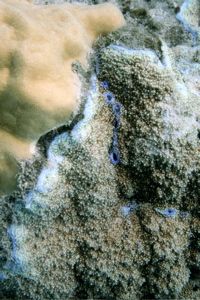 |
| competing corals |
The corals provide habitat for many invertebrates including Christmas tree worms, bio-eroding mussels, scallops, worm snails, crocus giant clams and other bivalves. Several Montipora spp. colonies were observed with hundreds of the “keyholes” formed by the bio-eroding mussel Lithophaga zittelliana, and the smallest of the giant clams, Tridacna crocea, was found embedded in colonies of Porites spp. Several species of nudibranch were observed on and underneath the coral rock on transect and Vitareef dives.
Five species of giant clam were observed on this reef. The crocus giant clam (Tridacna crocea) was most abundant, found in coral heads and coral rock. The fluted giant clam (Tridacna squamosa) and large giant clam (Tridacna maxima) were consistently found on the reefs in lower abundance than the crocus. The giant giant clam, Tridacna gigas, was sighted several times over the course of the study, although not on any transects. The china clam (Hippopus hippopus) was observed once, on a transect.
Two cuttlefish (Sepia spp.) were sighted on the reef. They swam around very slowly while three divers and a snorkeler observed them.
Sea cucumbers were abundant and diverse on this reef. Sea urchins were also noted, Diadema spp. and Echinometra mathaei being the dominant species. The sea stars Fromia indicta and Linckia laevigata, brittle stars and crinoids were also observed.
Tunicates were found attached to dead coral rock throughout the reef.
As our ship approached Lizard Island through Cook’s Passage on 6 July 2006 a pair of dwarf minke whales (Balaenoptera acutorostrata subspecies) were sighted. They circled our ship for quite a while, and the pod grew to ten whales over the course of four hours. They allowed the crew to swim with and photograph them for hours on end. Eventually the ship had to move on in order to reach our anchorage at Lizard Island by sunset. One Minke Whale followed the ship for thirty minutes before he disappeared under the ocean surface. Only 45 minutes later four spinner dolphins (Stenella longirostris) began to ride our bow. Another white cetacean raced past the bow and did not stop to play. The color and stubby dorsal fin leads us to believe that it was an Indo-Pacific Humpback dolphin (Sousa chinensis). The spinner dolphins rode our bow for about 15 minutes.
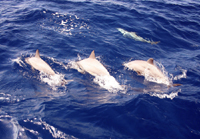 |
| Spinner dolphins riding our bow |
On 12 July 2006 an unidentified dolphin was sighted in the distance while riding in the zodiac back to the ship from a dive at Mermaid Cove, Lizard Island.
On the morning of 15 July 2006, the ship raised anchor at Lizard Island for an expedition to Cormorant Pass. Less than an hour after we were underway, a pod of six spinner dolphins rode our bow. After about five minutes, two of them shot off and disappeared. The remaining four played around our bow for another 20 minutes. Later that afternoon one dwarf minke whale was sighted near the “Snake Pit,” a reef between Lizard Island and Ribbon Reef #10.
The ship has had several dwarf minke whale encounters in this area of the Great Barrier Reef since the study at Lizard Island. See our cetacean log for more details.
No sea turtles were sighted on the Lizard Island reefs over the course of this study. Turtles are known to visit this area as one beach on Lizard Island is named “Turtle Beach” where Aborigines would hunt for turtles for traditional food. There are no nesting beaches on Lizard Island.
Although Mermaid Cove appears generally healthy, the most prominent threat to the reef is edge damage to the corals. Edge damage is a coral condition where filamentous algae traps sediment on an edge of the coral colony resulting in tissue necrosis. According to the Vitareef results, 19.68% of corals in the deep zone and 19.38% of corals in the shallow zone exhibited signs of edge damage. Previous studies have shown that edge damage can kill coral colonies at a rate up to 1cm per year, which is faster than the growth rate of some species.
Another potential threat to the reef includes crown of thorns sea star damage. These are voracious predators of corals. This reef has had crown of thorns outbreaks in the past. There are still some of these sea stars and traces of the damage that they cause to corals visible in Mermaid Cove but they are presently not at an epidemic level. However, their numbers could quickly increase in a short time potentially threatening the health of the reef.
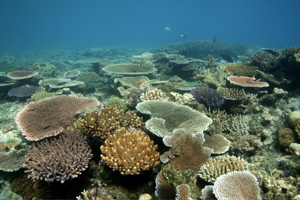 |
| View of shallows |